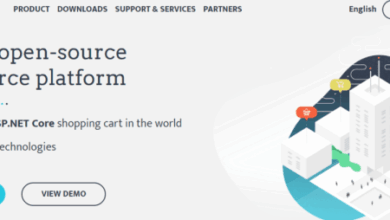
Will American Express crush small online players? This question probes a critical dynamic in the online payment processing landscape. American Express, a formidable player with a vast history and significant market share, is scrutinized for potential moves that could impact smaller businesses. This analysis examines the potential impact of American Express’s actions on the online business community, considering everything from their pricing policies to possible partnerships and future industry trends.
The analysis delves into American Express’s current market position and strategy, comparing it to competitors like Visa and Mastercard. It also explores the business models and challenges faced by small online businesses, including transaction fees and customer acquisition strategies. Potential impacts, competitive advantages, and even the possibility of partnerships between the two groups are examined. Finally, the discussion looks ahead to future trends in the online payment industry and how they could shape the relationship between American Express and smaller players.
Market Analysis of American Express
American Express, a global payments giant, holds a significant position in the financial landscape. Its history is intertwined with the evolution of credit cards and payment processing, shaping its current strategies and market presence. Understanding its current market position, historical performance, and competitive landscape is crucial for assessing its impact on smaller online players.American Express’s market strategy centers around building trust and brand loyalty through premium services and exclusive benefits.
Their focus on high-net-worth individuals and businesses, coupled with their extensive network of merchants, positions them as a key player in the global financial ecosystem. However, the competitive landscape is dynamic, and the rise of online commerce has presented both opportunities and challenges for the company.
Current Market Position and Strategy
American Express’s current market strategy prioritizes maintaining its position as a premium brand. This involves offering exclusive benefits and rewards programs to attract and retain high-value customers. They also actively seek partnerships with large merchants and businesses to expand their acceptance network, thereby enhancing their transaction volume and reach.
Historical Performance in Online Payment Processing
American Express has been a significant player in the online payment processing market since its early adoption of online transactions. Early efforts focused on building a secure and reliable online payment infrastructure. Over time, they have adapted their offerings to the changing demands of online commerce, including the increasing need for mobile payment options and enhanced security protocols.
Market Share Comparison
American Express’s market share in the online payment processing sector is notable, though smaller than that of Visa and Mastercard. This difference reflects their different target customer bases and the broader acceptance networks of Visa and Mastercard. The market share of American Express tends to be concentrated among high-spending customers and premium merchants.
Key Strengths and Weaknesses
American Express’s strengths lie in its brand recognition, strong customer loyalty programs, and extensive network of merchants, particularly in premium retail and high-value transactions. However, their acceptance network is potentially a weakness in comparison to Visa and Mastercard. Smaller online players might find it challenging to compete with the vast network of Visa and Mastercard.
Financial Health and Stability
American Express consistently demonstrates strong financial health and stability. This is evident in its robust profitability, healthy cash flow, and low debt levels, which provide a solid foundation for ongoing operations and future investments. Their financial performance demonstrates a resilient company well-positioned to navigate economic fluctuations.
Understanding the Online Player Landscape

Navigating the online marketplace requires a keen understanding of the players within it, especially the smaller businesses. Small online businesses often face unique challenges in terms of payment processing, customer acquisition, and competition. Analyzing their common business models, customer bases, and typical struggles provides valuable insight into the environment and the potential impact of larger players like American Express.Understanding the intricacies of this landscape helps in assessing the potential vulnerabilities of smaller businesses and the possible strategies they employ to thrive in a competitive market.
Common Business Models of Small Online Businesses
Small online businesses adopt a diverse array of business models. These models often influence their operational strategies, payment processing needs, and customer acquisition approaches. A few prevalent models include direct-to-consumer sales, online marketplaces, and subscription services. Understanding these models helps in tailoring strategies to specific business types.
- Direct-to-consumer sales:
- Online marketplaces:
- Subscription services:
These businesses sell their products or services directly to customers through their own online stores. Examples include handmade crafts, digital products, and consulting services.
Will American Express really crush smaller online players? It’s a big question, and the recent acquisition of a UK web developer site by Internet.com ( internet com acquires uk web developer site ) hints at a potential shift in the online marketplace. Perhaps the consolidation of services, as seen with this move, will create a powerful competitor, potentially making it harder for smaller players to compete.
So, while the answer to the initial question remains unclear, the future of the online landscape definitely looks interesting.
These businesses operate within existing online platforms, such as Etsy or Shopify, leveraging the platform’s infrastructure and customer base. These models often have established payment processing systems and customer acquisition channels.
These businesses offer recurring services or products to customers. Models like monthly software subscriptions or ongoing coaching programs often require streamlined payment processing systems.
Transaction Fees Charged by Different Payment Processors
Comparing transaction fees is crucial for small online businesses to optimize their operational costs. The fees charged by various payment processors can vary significantly, impacting profitability.
| Payment Processor | Transaction Fee (Example) | Additional Fees |
|---|---|---|
| Stripe | 2.9% + $0.30 | Potential monthly subscription fees, dispute fees |
| PayPal | 2.9% + $0.30 | Potential monthly subscription fees, seller protection fees |
| Square | 2.6% + $0.15 | Potential monthly subscription fees, processing time variability |
| Authorize.Net | 2.9% + $0.30 | Potential monthly subscription fees, setup fees |
Note: Transaction fees can fluctuate based on factors like transaction volume, currency exchange rates, and payment type. It is essential for small businesses to research and compare options carefully to choose the most cost-effective solution.
Customer Acquisition Strategies for Small Online Players, Will american express crush small online players
Effective customer acquisition is vital for growth. Small online players utilize various strategies to attract and retain customers. These strategies can be broadly categorized into marketing and customer service approaches.
- Search Engine Optimization ():
- Social Media Marketing:
- Email Marketing:
- Content Marketing:
- Paid Advertising (PPC):
Improving website ranking in search engine results.
Utilizing social media platforms to promote products or services.
Building email lists and sending targeted promotional messages.
Creating valuable content to attract and engage potential customers.
Running paid advertisements on search engines or social media platforms.
Typical Customer Base and Demographics of Small Online Players
Understanding the customer base is critical for tailoring marketing strategies. The demographics of small online players’ customer bases often vary depending on the specific products or services offered. For instance, a business selling handmade crafts might attract a different customer base than one selling software subscriptions.
- Demographics:
- Customer Preferences:
Customer demographics are crucial in tailoring marketing strategies. Businesses should analyze their customer data to understand their age, location, income levels, and interests to create effective marketing campaigns.
Customer preferences and buying behaviors are key to success. Understanding the type of products or services customers prefer can help businesses tailor their offerings and marketing efforts accordingly.
Common Challenges Faced by Small Online Businesses Regarding Payment Processing
Small online businesses often face difficulties in the payment processing realm. These difficulties can be attributed to a lack of expertise in the area, fluctuating transaction volumes, and the complexity of different payment options.
- Integration Complexity:
- Fraudulent Transactions:
- Scalability Issues:
- International Payments:
Integrating payment processing systems with existing e-commerce platforms or software.
Protecting against fraudulent transactions and managing chargebacks.
Adapting payment processing systems to accommodate fluctuating transaction volumes.
Wondering if American Express will squash smaller online players? It’s a valid concern, especially given how big players like big blue and Galeries Lafayette are jumping into e-commerce. This move signals a significant shift in the market, potentially making it harder for smaller businesses to compete. However, the landscape is constantly evolving, so it’s hard to say definitively if Amex will completely crush these smaller players.
Processing payments from customers in different countries, accounting for currency conversions and international regulations.
Potential Impacts of American Express’s Actions
American Express’s foray into the online marketplace presents a complex picture for small businesses. Their actions, ranging from pricing strategies to policy implementations, will undoubtedly have ripple effects across the digital economy. Understanding these potential impacts is crucial for both Amex and the burgeoning online business community. The balance of power and the competitive landscape are set to shift.American Express, with its established brand and significant financial resources, could potentially exert considerable influence over the online payment ecosystem.
This influence, if not managed carefully, could lead to increased costs for small online players, potentially stifling innovation and growth. Conversely, if implemented thoughtfully, Amex’s involvement could lead to increased security and streamlined transactions for consumers and businesses alike. The key lies in understanding the potential impacts and how these players might react.
Pricing and Policy Effects on Small Businesses
American Express’s pricing policies, if not carefully considered, could disproportionately affect smaller online businesses. Higher transaction fees or stricter acceptance criteria could lead to increased costs for these businesses, potentially making it harder for them to compete with larger established players. This could manifest as reduced profit margins or even the inability to operate profitably.
Potential Competitive Strategies by Small Online Businesses
Small online businesses must adapt to the evolving landscape. Strategies for competing with Amex’s potential dominance include exploring alternative payment gateways, emphasizing customer loyalty programs to reduce reliance on Amex, and highlighting the unique benefits of their services to differentiate themselves from Amex-focused competitors. Partnerships with other payment processors or fintech companies could also provide an avenue to counter Amex’s influence.
Possible Reactions of Smaller Online Players
Small online businesses will likely react in various ways to Amex’s actions. Some may choose to actively resist Amex’s policies by joining forces or lobbying for favorable regulations. Others might adopt a more passive approach, adapting to the changes and exploring alternative payment solutions. The level of resistance and the specific strategies employed will depend on the perceived severity of the impacts and the resources available to these smaller players.
Potential Scenarios for Direct Targeting
Amex could potentially target small online businesses through various avenues. These could include exclusive partnerships with certain types of online businesses or promotions that favor larger players, potentially creating a tiered system where small businesses face significant disadvantages. Amex could also employ targeted marketing campaigns aimed at driving customers to its own platforms, potentially cannibalizing the business of smaller online players.
Regulatory and Legal Considerations
The potential for anti-competitive practices and discriminatory policies requires careful consideration. Regulatory bodies will need to assess whether Amex’s actions infringe on antitrust laws or create unfair advantages for certain businesses. Transparency in Amex’s pricing models and policies will be crucial in maintaining a level playing field and ensuring fair competition.
Examining Competitive Advantages
American Express, with its deep history and established brand recognition, possesses a unique set of advantages in the payment processing landscape. Understanding these strengths, along with the limitations and potential responses from smaller online players, is crucial for predicting the future of online commerce. This analysis delves into American Express’s competitive advantages, comparing them to rivals and considering the factors that might hinder its impact on smaller businesses.American Express’s robust network and established customer base provide a significant competitive edge.
Its long-standing reputation for premium services and its history of handling high-value transactions create a distinct brand identity. This translates to a powerful network effect, where the value of the network increases with the number of participants. However, this advantage can also be a double-edged sword, as maintaining this premium positioning may limit its appeal to the mass market and smaller online businesses.
American Express’s Strengths
American Express benefits from a global network that spans numerous countries and currencies. This network facilitates international transactions, a crucial aspect for businesses operating across borders. Furthermore, its extensive merchant network and established customer relationships allow for streamlined transactions and reduced friction for consumers.
I’ve been pondering whether American Express will crush smaller online players. Recent reports of multi-million dollar e-commerce deals, like those detailed in usatoday com reports multi million e commerce deals , suggest a significant shift in the landscape. While these large deals might seem intimidating, the question of whether AMEX will overwhelm the smaller players remains open.
It’s a complex dynamic, and only time will tell.
Comparison to Other Payment Processors
While Visa and Mastercard dominate the volume market share, American Express holds a stronger position in the premium segment. American Express’s focus on high-value transactions and affluent customers allows it to offer tailored services and build stronger relationships. Conversely, Visa and Mastercard’s broader reach and acceptance by a vast number of merchants give them an advantage in sheer volume.
This difference highlights the diverse strategies employed by various players, each aiming to capture a specific niche in the payment ecosystem.
Factors Limiting American Express’s Impact on Small Players
American Express’s emphasis on high-value transactions might not directly benefit smaller online players. High transaction fees and the need for substantial merchant agreements could present significant barriers for these businesses. The perceived complexity of integrating American Express’s payment systems into their platforms may also discourage smaller businesses from adopting it.
Strategies for Small Online Players
Small online players can leverage their agility and cost-effectiveness to counter American Express’s advantages. Focusing on simpler, integrated payment systems that accommodate various options (including widely used alternatives like PayPal or Stripe) can be more appealing. Moreover, these smaller players can develop targeted marketing strategies to cultivate loyalty among their specific customer base. A personalized approach can foster a strong customer relationship, potentially offsetting the broader reach of established players.
Potential Responses of Small Online Players
Small online players might respond to American Express’s potential moves by exploring partnerships with other payment processors to provide wider payment options. Alternatively, they can emphasize user-friendly interfaces and streamlined transaction experiences to enhance their appeal. A clear understanding of their niche market and the needs of their specific customer base is crucial for survival and growth in a competitive environment.
Analyzing Potential Partnerships and Alliances
American Express, a titan in the financial world, is increasingly looking at partnerships to expand its reach and influence in the burgeoning online marketplace. This strategy presents a fascinating opportunity for both American Express and smaller online players, but also carries inherent risks. Understanding these dynamics is crucial to evaluating the potential impact on the broader market.Strategic partnerships can significantly amplify the value proposition for both American Express and smaller online businesses.
These collaborations can leverage American Express’s established brand reputation and financial infrastructure to introduce new products and services to a wider customer base. Conversely, smaller online players can gain access to a broader market and a more established customer base.
Possible Partnerships
American Express could partner with various types of small online players to expand its offerings and reach. This strategic alliance can provide mutually beneficial outcomes.
| Partner Type | American Express Benefit | Small Online Player Benefit |
|---|---|---|
| E-commerce Platforms | Access to a vast new customer base, expanding transaction volume, and diversifying revenue streams. | Access to a global customer network, enhanced brand visibility, and improved transaction processing infrastructure. |
| Subscription-Based Services | Potential for new revenue streams and diversified income sources, broadening its offerings beyond traditional credit cards. | Enhanced customer acquisition, improved brand recognition, and improved access to payment processing services. |
| Online Financial Services | Enhanced digital offerings, expanding into new financial products, and improving customer engagement through seamless integrations. | Access to a wider customer base, improved financial services offerings, and enhanced brand credibility. |
Potential Benefits
Strategic partnerships can create substantial benefits for both parties involved. American Express can gain significant market share and potentially develop new revenue streams. Smaller online players can achieve rapid growth, enhance their brand visibility, and gain access to more robust financial systems.
- Increased Market Share: American Express could significantly increase its market share by reaching new customer segments through online partnerships. For example, a partnership with a popular online clothing retailer could expose American Express’s payment system to a large customer base.
- New Revenue Streams: Partnerships could open up new revenue opportunities for both parties. A subscription service for online groceries partnered with American Express could offer bundled discounts or loyalty programs, generating additional revenue for both.
- Enhanced Brand Recognition: American Express can enhance its brand image by association with trusted online platforms. This is demonstrated by collaborations in other industries, like partnerships with travel agencies, improving brand visibility and trust.
Potential Risks
Despite the potential advantages, partnerships also present risks. Compatibility issues, differing business models, and a lack of trust between parties can lead to failure.
- Compatibility Issues: Integrating different systems and business processes can be complex. For example, a partnership between American Express and a subscription-based service might encounter difficulties in data integration or customer service coordination.
- Differing Business Models: Disagreements over revenue sharing, profit margins, and customer service responsibilities can strain the partnership. This is often seen in collaborations where one party is significantly larger than the other.
- Loss of Control: Partnerships require a degree of trust and give up a degree of control over operations. This can pose a risk to the autonomy of either party if not carefully managed.
Creating a Win-Win Scenario
A successful partnership requires a clear understanding of the mutual benefits and careful consideration of potential risks. Transparent communication, well-defined contracts, and mutual respect are crucial to a productive alliance.
- Clear Communication: Open and transparent communication is essential to address potential concerns and ensure alignment on strategic goals. Regular meetings and clear communication channels are vital to maintain the partnership.
- Detailed Contracts: Comprehensive contracts must Artikel roles, responsibilities, revenue sharing, and dispute resolution mechanisms to mitigate potential conflicts.
- Mutual Respect: Recognizing the unique contributions and perspectives of each partner is critical for building a strong and enduring alliance. Respect for each party’s independence is vital.
Future Trends and Predictions
The online payment landscape is in constant flux, shaped by technological advancements and shifting consumer preferences. Understanding these trends is crucial for both established players like American Express and smaller online businesses navigating this dynamic environment. Predicting the future is never precise, but analyzing current trends allows for informed speculation and strategic planning.
Key Trends Affecting Online Payment Processing
The online payment processing industry is experiencing a rapid evolution driven by several key trends. These include the increasing adoption of mobile payments, the rise of digital wallets, and the growing importance of security and fraud prevention. Furthermore, the integration of AI and machine learning into payment systems is automating many processes and enhancing customer experience. These factors collectively impact how transactions are processed, how customers interact with payment systems, and the overall security of online transactions.
Impact on American Express and Small Online Players
The evolving landscape presents both opportunities and challenges for American Express and small online businesses. American Express, with its established brand recognition and robust infrastructure, can leverage these trends to enhance its customer base and maintain its market share. Small online players, on the other hand, might face increased competition from new entrants and need to adapt quickly to maintain their competitive edge.
Future Scenarios for the Relationship
Several scenarios for the relationship between American Express and small online players are possible. One potential scenario involves American Express partnering with small online businesses to provide tailored payment solutions, leveraging its extensive network and expertise. Another scenario could see American Express expanding its services to include more competitive pricing models that encourage greater adoption among small online businesses.
Conversely, there could be a continued emphasis on American Express’s premium offerings, potentially leaving smaller players to find alternative payment processors. The specific outcome will depend on the strategies adopted by both parties.
Business Strategies for Small Online Players
Small online players need to adapt their business strategies to navigate the evolving payment landscape. They should consider offering various payment options to accommodate a broader range of customer preferences. Prioritizing security measures and implementing robust fraud prevention systems is critical. Furthermore, partnering with innovative payment processors that offer competitive pricing and reliable services is crucial for survival.
Finally, staying abreast of the latest technological advancements and adopting innovative solutions is essential for maintaining a competitive advantage.
Summary of Potential Changes in the Online Payment Landscape
The online payment landscape is likely to become more complex and competitive in the future. Mobile payments will likely become more integrated into daily transactions, potentially impacting the use of traditional credit cards. The emphasis on security and fraud prevention will continue to be paramount. Small online players will need to adapt to the changes to maintain their market share, while American Express will need to adjust its strategies to cater to the evolving needs of the online marketplace.
The overall result is a more sophisticated and potentially more accessible online payment system.
Ending Remarks: Will American Express Crush Small Online Players

Ultimately, the answer to whether American Express will crush small online players remains uncertain. The analysis highlights the complexities of the situation, revealing that the outcome hinges on a multitude of factors. American Express’s actions, the resilience of small businesses, and the evolving payment landscape will all play a crucial role in shaping the future of online commerce.
It’s a compelling debate that highlights the ongoing struggle for market dominance in the digital age.






